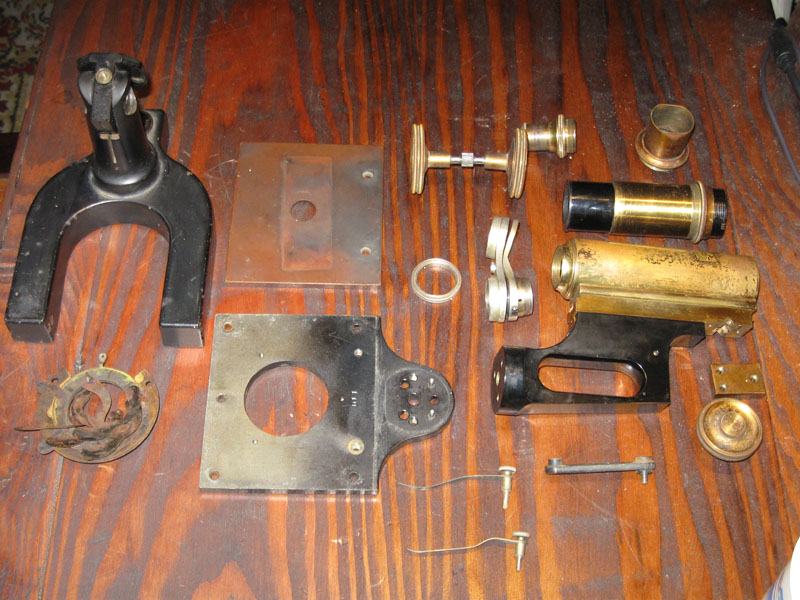
The Novitiate’s Odyssey.
Episode One: How I got involved in Microscopy for all the wrong reasons.
by G. Joseph Wilhelm, Florida Keys, USA
It was a dark and stormy night. Actually it was just dark and my computer screen was flashing a congratulatory announcement from that grand bastion of capitalism known as eBay. I now had one year tenure as a buyer and indeed, it was this very organization that started me on this trek down the path to the miniscule, and this article.
I have been an ardent habitué of Micscape Magazine since first discovery some time ago. The hours of pleasure derived from the current and past issues has been immeasurable, the content scholarly and informative but I have recently come to realize that a very unique and important perspective of microscopy was missing from this eminently distinguished publication…..mine. Egad I thought! A subject without my opinion? Tut-tut my good man, unimaginable! But what possible aspect of microscopy was I qualified to expound upon? Why, ignorance of course. I certainly had adequate competence in that respect. The idea for an article of, by and for the beginner, written about my BM era (Before Micscape) began to take form.
Now, after some time of leisurely reflection here in the tropics with pen in hand, tongue in cheek and a tall frosty mug of rum, I humbly submit this discourse which upon conclusion may give Micscape Magazine pause to reconsider their policy of soliciting literary contributions from just “anyone”. This is the journey of a true beginner, and while my credentials in Microscopy are non-existent, (none, zip, nada), it does enjoin me with such luxury which allows me to speak with a sanguine authoritativeness without angst over deleterious repercussions to my also non-extant reputation.
It has been my experience that in order for an intended audience such as yourselves to fully digest the pearls of observational wisdom I am about to cast, I find it necessary to properly place them in context by dispensing a short biography so you know just whom and what you are dealing with. So please allow me to beg your kind indulgence for a moment.
I am G. Joseph Wilhelm, and although I will soon be accepting felicitations on the anniversary of my sexagenarian nativity, I still find myself using words like “keen”, “neat”, “nifty” and “awesome”, (thankfully falling short of voicing those horrid Californiaisms such as “dude” and “gnarly”). Speaking of words, “eccentric” has been used as an adjective and noun to describe me, also eclectic, esoteric, amiable, irreverent, daft and having “bats in my belfry”.
I reside in the Florida Keys quite close to Key West. That means my wife’s hairdresser is straight, Joe the plumber is gay, we elected a local bar owner as our Mayor and most people can’t remember…is pot illegal? But that is not to say we are entirely devoid of intelligentsia. There is the occasional oasis of academia such as the Mote Marine Laboratory, the NOAA facility, the marine biology department of the community college and Sloppy Joe’s Bar which is where the aforementioned facilities personnel meet to quaff their favorite libation and engage in what I am sure is cerebrally stimulating biological scholastic conversation. (How ‘bout dem Dolphins/Marlins/Gators?)
Gainful employment is realized as a successful civilian Explosives Safety Instructor for the Naval Air Warfare Center Key West Detachment. I say “successful” because unlike many of the grizzled twenty year veteran Weapons and Gunner Master Chief in my peer group I not only can hear the waitress ask what I would like to drink, I also do not require both hands to display enough digits to order five beers.
Finally, I am a collector of antique things that have a mechanical purpose. In my home there are 38 separate assemblages of antique typewriters, sewing machines, WWI firearms, brass padlocks, straight razors, time pieces, telephones, telegraphs, apothecary, tobacco pipes etc. etc… you get the picture. In the optics collection section are telescopes, binoculars, kaleidoscopes, spectacles and cameras. Obviously lacking (yes, here comes the anticipated segue) was a representative example of an antique microscope.
There you have it.
To paraphrase the late great custom motorcycle builder, Indian Larry, the main appreciation (for myself) of the articles in this aggregation is of their pronounced visual “mechanicalness”. I find working mechanical mechanisms are a thing of beauty, much more so with those of the late 19th and early 20th centuries. They went beyond utility and incorporated the Victorian flair, the Art Nouveau or Art Deco design, a delight to ponder and an observable testimonial to engineering and manufacturing preciseness. Such was my desire to have the polished brass components and the intricate assembly of an antique microscope to display in my optics collection.
So the quest began.
I had a mental picture of the Sherlock Holmes scopes that were on the scientific apparatus table found in every Basil Rathbone film but a cursory investigation proved the 19th century Becks, Watsons and others that fit my mind’s image were in the thousands of dollars. Pursuance of a more practicable solution was in order. While engaged in this endeavor I soon became awash in unfamiliar terms, descriptions and information. By the end of the month I had amassed a mountain of micro technological erudition.
It would not be unfair to state that at the onset of this quest it would be difficult to find an individual less obtuse of the microscopic discipline than moi. It was at this juncture that I had an epiphany into a casual remark said by one of my redneck, snuff dippin’, four-wheelin’, right wing, social counterpoint, fishin’ buddy associates (his name is Chauncey), and I quote; “Knowledge ain’t worth #!&% iffin yew don’t unnerstan’ it”.
How true.
The authors of the articles and essays I have absorbed, even those intended for beginners, seemed to assume I had some sort of prerequisite level of education and comprehension of the subject. This was the same error of judgment my college chemistry professor made. My collective experience only consisted of a Christmas present ‘Tasco’ or ‘Perfect’ (I cannot recall) brand microscope kit at the age of nine. I do remember it had a coarse and fine focus, mechanical stage, some prepared slides and magnification up to 1200X. But the combination of being nine, having the Alfonso Bedoya mindset of “Instructions? We don’t need no stinking instructions” and getting no satisfaction trying to view whole dead birds under 1200X led to an early abdication of interest. However, never having been one to let my ignorance stand in the way of my education, I have plodded forth with my habitual “intellectual abandon”. Thus my forward progress into enlightenment has been punctuated with “fits and spurts of unnerstanin” as Chauncey would so eloquently pronounce.
I crossed over to the dark side while at work, sharing my lamentable situation over obtaining a microscope.
Up to this point I had never actively pursued procurement of additions to my collections. They had all been obtained by purchases of opportunity, those glorious moments of good fortune that appear from nowhere to afford one with a desirable object at a good price. Alas, no such circumstance seemed to be manifesting itself and after hearing me bemoan my situation, the Devil, in the guise of a co-worker, slithered up next to me and hissed in my ear ‘eeeeeebaaaaay”. I knew nothing about this nefarious tool of the underworld and wasn’t to find out until later that it was like a snake, you had to handle it carefully or it would bite you. I dutifully went to the eBay site and typed in “Antique Microscope”. ZOUNDS! I was assailed by 173 “hits” in that category and now, irretrievably ensnared, I spent the next few days in what I believed to be fortuitous bliss perusing the proffered possibilities.
I narrowed down the list to ten microscopes and being enveloped with an impulsive impatience I applied my usual modus operandi (see Alfonso Bedoya reference above) and bid on all ten at $100 each, figuring when I won one I could retract all my other bids.
My rude awakening came immediately after being appraised that unless I was deceased, if I withdrew any bids, eBay would tar and feather me, ban me from society for life and all my good deeds, past and future would be expunged from the book of life.
Ah, the trepidation I experienced over the next week was tremendous, the possibility of paying out a thousand dollars notwithstanding, I was aghast at the potentially devastating dent it would make in my rum budget.
Now bear in mind also, that I had absolutely no idea of what I would be getting other than what was depicted in the pictures. Most of the descriptions started with “I don’t know much about these..” and I was not educated enough at this time to put forth pertinent questions (I believed that ‘parfocal’ meant intense concentration on a golf game). I have a small shop lathe and milling machine plus experience in curatorial care and restoration so any minor mechanical flaws listed did not deter me. I bid simply on what the microscope looked like and whether or not it would be an apropos accoutrement to my mini museum.
After considerable genuflecting between the computer and the ATM, the fates smiled benevolently and allowed me to extricate myself from this situation for a mere $287.00 including shipping. A pittance! I had won the bidding on six microscopes.
So…what did I receive? A resounding education. (For tis upon the mistakes of learned men that the foundation of future edification can be built). I was now the chagrined owner of three Spencer, two Bausch & Lomb and one San Francisco Technical Institute microscopes. After a few months of research here is what I found I have. Photos and descriptions follow with a special thanks to the P. S. Neeley site for help in identification:

Fig. 1- Bausch & Lomb BH “Jug Handle” stand disassembled for restoration. The SN indicates 1907 as the year of manufacture. The fact that it has no eyepiece, the eyepiece tube and coarse focus pinion axle are both bent, there is no mirror, an irreparably damaged stage iris and bent nosepiece turret are not insurmountable obstacles to the application I now have planned for this apparatus. “Stay tuned” as they say. Price with shipping was $16.50.
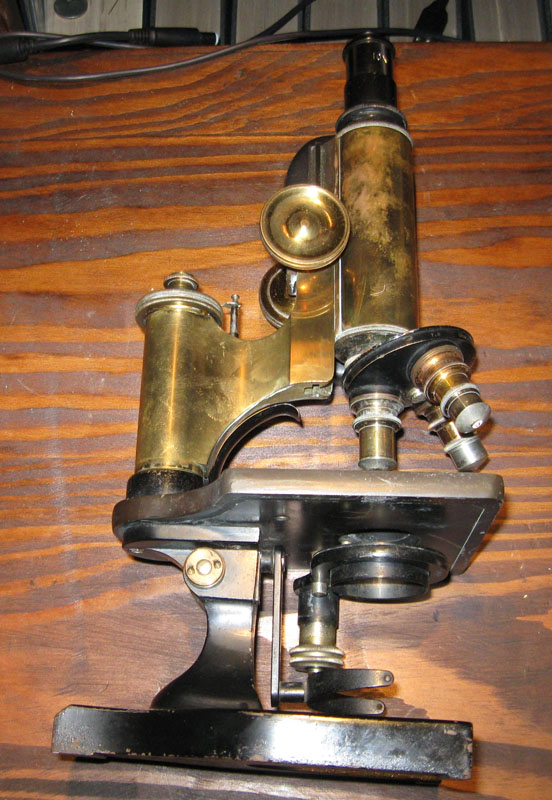
Fig. 2- Behind curtain number two we have a circa 1912 Spencer Lens Co. stand. Has mirror fork and condenser holder but no mirror or condenser, coarse focus pinion axle slightly bent and the arm to stage connection is loose. This is close to the all brass style I was originally interested in. I will be attempting to adapt a condenser and mirror to complete this scope. Total w/ shipping $57.00.
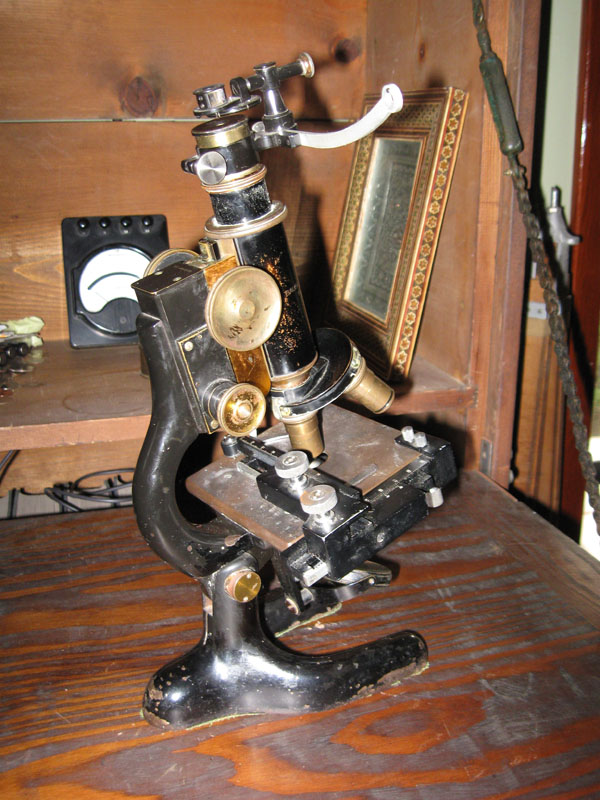
Fig. 3- This is a Bausch & Lomb that I cannot find a Serial Number on. There is a patent date of 1915 but I believe it to be manufactured in the 1920s. It is very similar to the Spencer model 19 and model 44 of that era but this is only a guess. It is complete with correct objectives but I am not sure about the mechanical stage, this particular detachable one seems just a little out of place. The base inclination joint is seized but that should not be difficult to correct. Coarse and fine focus is very smooth with no backlash. Best scope of the lot. Final total price was $93.00.
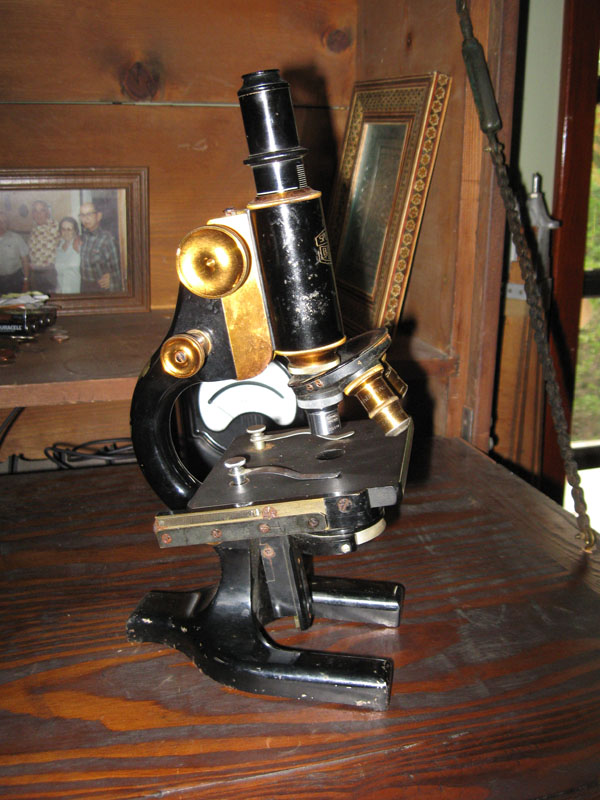
Fig. 4- Here is another Spencer, a Model 44MH that dates to 1932. The latest Spencer catalog I have is dated 1929 and was identified from that. It’s missing the mirror; the rack gear is the only part of the permanently mounted mechanical stage that is left. It has a Leitz low power objective that is definitely not original equipment but over all not a bad piece of equipment for $47.00 delivered.
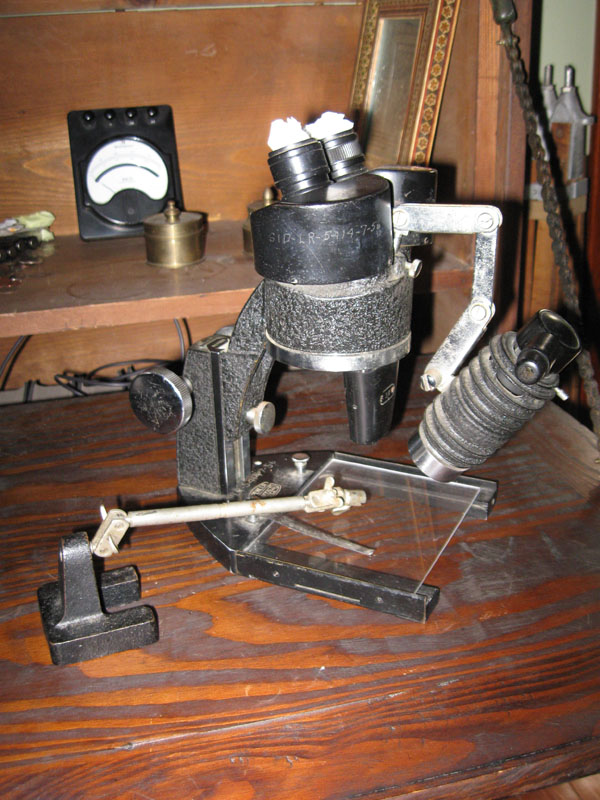
Fig. 5- Spencer described this design as a “Binocular dissecting microscope” in their 1929 catalog. This 1944 version has the eyepieces tilted back at 45 degrees unlike the straight tubes of earlier models and today they are referred to as stereo microscopes. It came with a really nifty miniature horseshoe base double-jointed alligator clip specimen holder thingy, and a light. There is a dovetail slot underneath the base/stage that may have allowed it to be attached to another piece of apparatus. It came with 10X eyepieces and a 1X and 3X objectives. If I add 15X and 20X eyepieces it will have a really nice range of low power magnification. $46.00
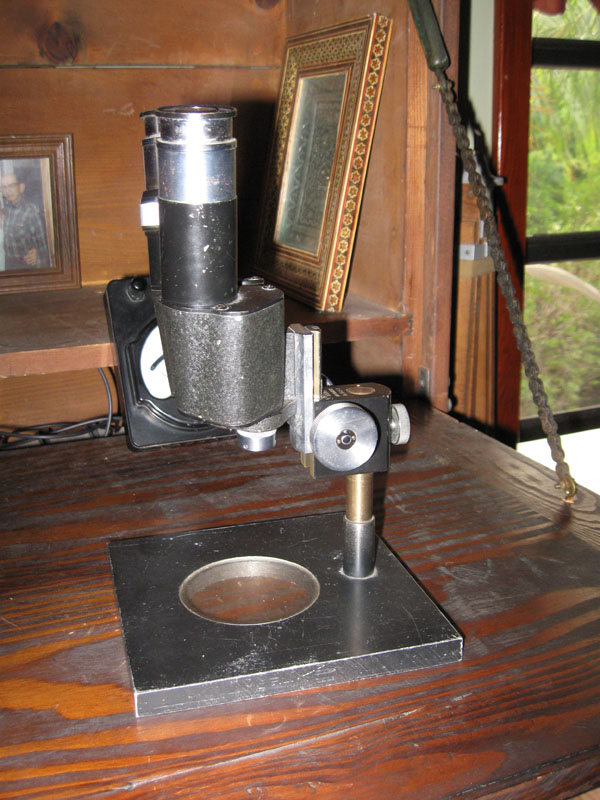
Fig. 6- The ugly duckling. I have absolutely no idea of why I bid on this instrument. It’s an off brand and not an antique. It only has one magnification and I am not sure what that is, there are no markings on the objectives and only 10X on the eyepieces. The oculars fit a 30mm tube, which is too big to use on the other scopes. It’s ergonomically challenged; the viewing is straight down and nothing in the mechanism tilts. It accounts for the remaining $27.50
The tomfoolery related above took place about a year ago and in that time I have become quite familiar with the mechanical aspects of microscopes and I have done a few repairs, cleaning etc. and they now reside in one of my display cases looking very noble and microscopicalish. I thought this was the end of my re-introduction to microscopy but nay; all it took was an audacious suggestion by my wife that I should consider looking through them instead of at them. Hmmm…what a concept.
The net result was a rekindling of interest that may fuel future prognostications and additional episodes from myself. A myriad of topics comes to mind that I will address commentary to at a later date. But for now, as a guest who may have stayed too long, I feel I must depart, but conclude with the following assertions, assumptions, pronouncements and advice for the truly clueless beginner (such as myself) in order to justify my original intent to this article for the microscopy novice.
For the beginner:
Step (1)- Research.
Step (2)- Read, understand and assemble a consensus.
Step (3)- Add your personal settings.
Step (4)- Apply liberally any measure of common sense you have been blessed with.
Step (5)- If any problems with steps (2 thru 4) repeat step (1) as much as necessary.
Only then should you feel prepared to take action i.e. spend money.
This simple formula can be applied to any aspect of microscopy. Here is an example of how it would work for “I want to buy a microscope”.
Step (1) Find a minimum of four articles on how to buy a microscope, more is better.
Step (2) After reading; note the points they agree on. If there are terms or information you don’t understand then revert to Step (1) to clarify them and back to step until you have such a grasp and understanding as can be reasonably expected.
Step (3) Budget, level of expertise, intended use, spousal approval etc. are some of the considerations here.
Step (4) This is the most difficult. Ask yourself; Have I been honest with myself in the previous steps? Do I have recourse if I am not happy with my purchase?
Is this what I need or just what I want?
OK class, since buying a microscope is one of the first expenditures a beginner will make, here is your homework assignment using the above method. Remember I am teaching you to fish, not giving you the fish.
Things you need to know:
The difference between Stereo, Binocular and Monocular microscopes.
Tube length; 160mm, 170mm and infinity corrected.
Oculars (eyepieces) 10X and under to 20X and best applications.
Objective lens types; achromat, plan achromat, and apochromat, dry and oil immersion.
Objective lens parfocal length, both DIN and JIS.
Sub stage condensers and their function
Resolution and contrast.
This will give you a good foundation to work from and with which to make informed decisions and questions. (Lest I insult the intelligence of the more advanced and educated personages that, by happenstance, have navigated the essay thus far, let me state this article was originally intended for my young cousin heir to my microscopes. He is a neophyte to microscopy.)
It is also important to know that neither myself nor other individuals dispensing information to the novice should ever presume to be the final authority on the subject being discussed.
I found a remarkable video, the best introduction microscopy I have ever seen at http://www.archive.org/details/imaging_a_hidden_world Bruce Russell’s video brings to life aspects of microscopy that can never be fully conveyed with just the printed word.
So in summary, the important lessons we have learned here are:
Don’t run with scissors and never eat on an empty stomach, it will ruin your appetite.
The curtain is closing at last, and I my friends, must take leave to mount my steed, poise my lance of inquisitiveness and charge forth to pierce those ramparts resisting entry into those repositories of knowledge microscopic. Until next time, I bid you adieu.
Comments, accolades, constructive criticisms and minor discontent can be addressed to me. Insults, slurs, derogatory remarks and other verbal expressions of malcontent can also be addressed to me, as I am an equal opportunity proponent.
Published in the September 2009 edition of Micscape.
Please report any Web problems or offer general comments to theMicscape Editor .
Micscape is the on-line monthly magazine of the Microscopy UK web site atMicroscopy-UK
© Onview.net Ltd, Microscopy-UK, and all contributors 1995 onwards. All rights reserved.
Main site is at www.microscopy-uk.org.uk with full mirror at www.microscopy-uk.net .